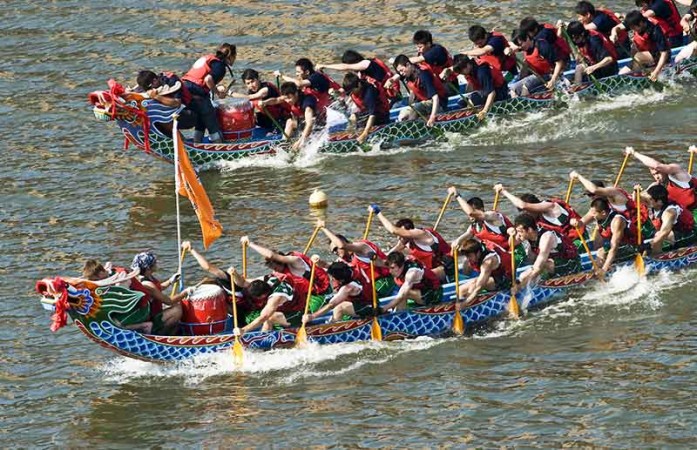Dragon boats are the basis of the team paddling sport of dragon boat racing, a watersport which has its roots in an ancient folk ritual of contending villagers, which has been held for over 2000 years throughout southern China. While competition has taken place annually for more than 20 centuries as part of religious ceremonies and folk customs, dragon boat racing has emerged in modern times as an international sport, beginning in Hong Kong in 1976. But the history of dragon boats in competition reaches as far back as the same era as the original games of Olympia in ancient Greece. Both dragon boat racing and the ancient Olympiad included aspects of religious observances and community celebrations along with competition.
They were traditionally made in the Pearl River Delta region of China’s southern Guangdong Province out of teak wood (mostly imported from Pontianak, Indonesia) to various designs and sizes. In other parts of China, different kinds of wood are used to build these traditional watercraft. It is one of a family of traditional paddled long boats found throughout Asia, Africa, the Pacific islands and also Puerto Rico. Currently, boats are being made for competitive purposes out of carbon fiber and other lightweight materials.

Dragon Boat Racing
[source]
The crew of a standard dragon boat is typically 22, comprising 20 paddlers in pairs facing toward the bow of the boat, 1 drummer or caller at the bow facing toward the paddlers, and 1 sweep (a steerer) standing at the rear of the boat. Dragon boats however vary in length and the crew size will change accordingly, from small dragon boats with 10 paddlers up to the traditional boats which have upwards of 50 paddlers, plus drummer and sweep.
The pulsation of the drum beats produced by the drummer may be considered the “heartbeat” of the dragon boat. Good drummers should be able to synchronize their drumming with the strokes of the leading pair of paddlers, rather than the other way around.
The paddlers sit facing forwards in the boat, and use a specific type of paddle which, (unlike rowing sweep, or scull), is not rigged to the racing watercraft in any way. Therefore, Dragon boaters are paddlers not rowers or oarsmen. They are also mixed, there could be also oarswomen in the crew.
The sweep, known also as the steersman, steers the dragon boat with a sweep oar rigged at the rear of the boat, generally on the left side. This is done by using the oar as a rudder, while the boat is moving, or by sweeping the stern of the boat sideways by pulling or pushing water with the oar as the boat is moving slowly or stationary.
Modern dragon boat racing is organised at an international level by the International Dragon Boat Federation (IDBF). Although it is not officially considered a sport by the General Association of International Sports Federations (GAISF) Festival Racing is very competitive. Many competitive paddlers train all year round using paddling machines or pools to train in during the winter.
Today, dragon boat racing (sport and festival) is among the fastest growing of team water sports, with scores of thousands of participants in various organisations and clubs in over 60 countries – 62 of which are IDBF members (as of 8 Jan 2009). The sport is recognised for the camaraderie, strength and endurance fostered amongst participants, and it has also become a very popular corporate and charitable sport.
If you like what you read, please subscribe to this blog by completing the form. If you want to help more, start by following us on Twitter, and like our page on Facebook. You don’t know what good things may happen. To lighten your day, check our pins on Pinterest, we can be friends there too. Oh, and if you need a really good looking blog attached to your site, or just for fun, to express your feelings more competitively, read this Own Your Website offer! Thank you very much.
